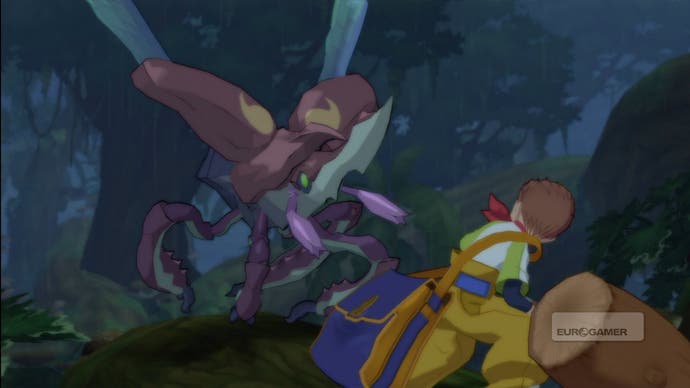Tales of Vesperia
Yuri update?
In a genre obsessed with world-threatening crises, Tales of Vesperia's initial focus on a local emergency is refreshing. It's the fantasy equivalent of a burst water main: a magical fountain whose powering gem-stone has been stolen, causing water to flood the lower district of Zaphias, the medium-sized city in which your character resides.
Yuri is on the far side of adolescence, one of the more prominent young men from this, the poor side of town, and he leaps at the chance to help out his people. After all, the soldiers whose job it is to protect and serve Zaphias have no interest in the plumbing problems of the underclass, particularly when there's an aristocracy to pander to. In time, the theft of the gem turns out to be a small cog in a greater plot machination, but the game never forgets its small-scale, neighbourhood beginnings.
That said, it would be untrue to claim Tales of Vesperia's themes stray too far from the deep narrative furrows along which most JRPGs tread (although it takes a few hours for that global crisis to step out from behind the dramatic curtain), or to imply that its scale is anything but grand. But it'd be equally unfair to chastise the game for cliché. It may do little to reinvent its series' template, as, in contrast to Square-Enix, Namco is happy for its flagship RPG series to stick to its long-established form, but the execution fizzes with creativity. The solid, dependable framework allows the developer to concentrate its efforts on crafting a witty, engaging script, characters with depth and intrigue, and a world of detail and some nuance, which it does.
Yuri, in particular, is a strong protagonist. Old enough to be appealing to any player past their teens, yet flawed enough to be believable, he remains heroic enough to provide the leadership his role requires. Especially notable is the voice acting, which, while universally American in casting, is unusually well-acted, elevating the dialogue to something more engaging than genre fans will be used to. As if to capitalise on this, characterisation is shoved to the fore - an optional press of the back button at almost any point triggers a 'skit', a conversation between your team-mates about the current plot concern (with an Achievement for listening to all 500-odd of them).

Tales of Vesperia is a traditional JRPG in most other ways. You chase the storyline from city to city, battling monsters en route across the overworld map and fighting your way through dungeon areas to trigger the next cut-scene. Cities are relatively small despite being filled with NPCs just dying to tell you about nothing in particular, and this geographical succinctness allows the story to canter along at a decent pace, even if you do get caught up in the numerous side-quests and mini-games.
Enemy encounters are all visible in the field, so there are no random intrusions to interrupt your progress and inside battles the mechanics are unusual. You enjoy direct control over Yuri, with the other characters in your squad competently controlled by the AI (whose behaviour can be influenced by menu choices). You have free roam of the battle area and can attack in real time, where the B button performs standard linked attacks and the A button pressed in conjunction with directional inputs executes more powerful combos known as 'artes'.



